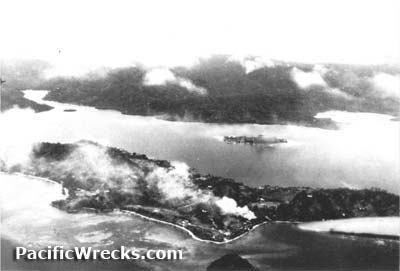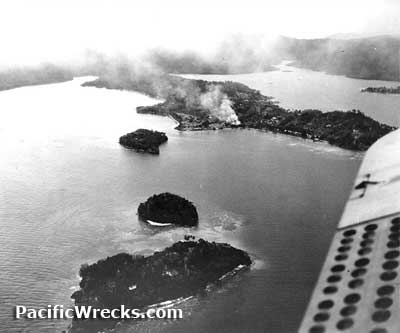Japanese missions against Tulagi, Tulagi Seaplane Base, Guvutu
January 22, 1942–May 3, 1942
January 22, 1942
(IJN) Japanese aircraft bomb the Tulagi. This was the first Japanese air raid against the Solomon Islands. On the ground, Solomon Islands
Defense force member Fala fired on the attacking planes.
March 17, 1942
(IJN) Three Type 97 Flyingboats bomb Tulagi Seaplane Base causing minor damage to one moored Catalina.
March 19, 1942
(IJN) Type 97 Flying boats and land attack bombers bomb Tulagi Seaplane Base causing slight damage and killed some locals on Tulagi Island.
April 9, 1942
(IJN) Five Type 97 Flyingboats bomb Tulagi Seaplane Base destroying the airmen’s quarters and damaged the store and kitchen and temporarily cut power and radio.
April 25, 1942
(IJN) Eight land attack bombers bomb Tulagi Seaplane Base from roughly 4,000' and damaged some buildings with some of their bombs landing in the harbor.
April 29, 1942
(IJN) Three
Type 97 Flyingboats bomb Tulagi Seaplane Base and damage two moored Catalinas including Catalina A24-23. RAAF sources record this attack as April 30, 1942.
May 2, 1942
(IJN) RAAF Catalinas from Tulagi spot the Japanese "Shima Force" to the northeast in the Solomon Sea bound for Tulagi and attack but due to bad weather fail to inflict any damage. Starting at 6:00am until 5:00pm Japanese floatplanes conduct strafing raids against Tulagi. Meanwhile, the RAAF officer in charge, F/O R. B. Peagam from No. 11 Squadron realized the small detachment of roughly fifty personnel could not opposee the Japanese landing and were order to evacuate and before departing demolish the seaplane base then withdraw to Florida Island and embark on a ship bound for Port Vila on Efaté then onward to Australia.
May 3, 1942
(IJN) A Japanese flying boat attacks Tulagi and sank the RAAF crash boat. Tulagi is occupied by the 3rd
Kure Special Naval Landing Force (3rd Kure SNLF) occupy the area without opposition.
May 4, 1942
(IJN) E8N2 Dave floatplanes intercept
U.S. Navy carrier bombers striking Tulagi but fail to inflict any damage. Three F1M2 Petes from Kamikawa Maru were intercepted by two of the Wildcats and claimed as shot down.
References
The First Solomons Air Campaign (2024) by Richard Dunn
American missions against Tulagi and Guvutu
May 4, 1942–August 7, 1942
May 4, 1942
(USN) USS Yorktown (CV-5) carrier planes conduct three consecutive strikes against Japanese ships off Tulagi. The first strike at 8:15am includes twenty-eight SBD Dauntless dive bombers armed with 1,000 pound bombs from VB-5 and VS-5 plus a dozen TBD Devestators each armed with torpedo from VT-5. The bombers were escorted by eighteen F4F-3 Wildcats from VF-42. Over the target, they find only small vessels and landing
craft. The Devestaors target Kikuzuki but miss due to faulty torpedoes and fogging telescopic bombsights. Only TBD Devastator pilot Ed Williamson scored a torpedo hit the starboard machinery room that leaves it dead in the water and is later beached and sinks the next day. They also attack Tama Maru and WA-1, WA-2.
In the mid morning, a second strike was launched including twenty-seven SBDs and eleven TBDs Devestators that arrived around noon and were intercepted by Type 95 (E8N2) with two floatplanes were claimed by SBDs, one in the air and one on the water. Meanwhile, the TBDs also encountered floatplanes when they attempted unsuccessfully to torpedo Okinoshima. Returning, one TBD became separated and ditched low on fuel near the south coast of Guadalcanal.
A third strike was launched led by four F4F-3 Wildcats from VF-42 to intercept any Japanese planes that might attempt to intercept and engaged three F1M2 Petes from Kamikawa Maru and claimed all three as shot down. Returning, due to bad weather and equipment failures, two Wildcats ditched off Guadalcanal. Afterwards, the downed pilots were rescused. In total, the Japanese lost five floatplanes and one damaged.
July 3, 1942
(5th AF) One A-24 bombs Tulagi [sic, this is likely a location in New Guinea].
July 23, 1942
(SOPAC) 11th Bombardment Group
B-17s on New Caledonia begin photo reconnaissance of the Guadalcanal-Tulagi-Gavutu
area.
July 29, 1942
(USN) During the night of July 29-30, 1942 three PBY Catalinas from VP-23 strike Guadalcanal and Tulagi at night. At Tulagi fragment damage was inflicted on a large flying boat. At Guadalcanal one bomb exploded near an AA gun killing one sailor and wounding another from the 84th Guard Force. Another bomb wounded two engineers in the billeting area. A truck and a roller were demolished.
July 30, 1942
(SOPAC) 11th Bombardment Group
B-17s on New Caledonia begin photo reconnaissance of the Guadalcanal-Tulagi-Gavutu
area.
July 31, 1942
(USN) During the night of July 31-August 1, 1942 three PBY Catalinas from VP-14 strike Guadalcanal and Tulagi at night.
August 1, 1942
(SOPAC) Seven B-17s from 98th BS, 26th BS and 431st BS strike Tulagi Seaplane Base and claim hits on barracks, buildings and a four engined flyingboat destroyed. The B-17s were intercepted by six A6M2-N Rufes and claimed two shot down but they were only damaged and returned safely. The Japanese reported two flyingboats damaged by repairable. The bombing resulted in three casaulties including one killed.
August 7, 1942
 (USN) Air support for the
Marines first amphibious landing of World War II was provided by three
carriers
of Air Support Force under the command of Rear Admiral L. Noyes plus Navy, Marine, and Army
units of Aircraft, South Pacific (COMAIRSOPAC) under the command of Rear Admiral John S. McCain operating from
bases on New Caledonia and New Hebrides. SBD Dauntless dive bombers strike Gavutu and Tulagi Seaplane Base and claiming seven large seaplanes burned. Warships conduct a pre invasion bombardment striking targets on Gavutu and damage the seaplane ramp and Tanambogo. (USN) Air support for the
Marines first amphibious landing of World War II was provided by three
carriers
of Air Support Force under the command of Rear Admiral L. Noyes plus Navy, Marine, and Army
units of Aircraft, South Pacific (COMAIRSOPAC) under the command of Rear Admiral John S. McCain operating from
bases on New Caledonia and New Hebrides. SBD Dauntless dive bombers strike Gavutu and Tulagi Seaplane Base and claiming seven large seaplanes burned. Warships conduct a pre invasion bombardment striking targets on Gavutu and damage the seaplane ramp and Tanambogo.
 (USMC) At noon, landing craft land the U.S. Marines Corps (USMC) 1st Paratrooper
Battalion on Guvutu. The original force missed the small (about 30
yard across) "bay"
or slipway area, which is adjacent to the north east slope of the hillock
and land about 30 yards north of the "bay" in along
a straight piece of the coastline 30–40
yards long, and the water laps a low bank, and the Marines were immediately pinned down by gunfire for some time. Defending, the Japanese were entrenched
in caves and bunkers and fought fanatically until eliminated. During the Battle of Gavutu, the Marines were accidentally shelled and
bombed by friendly forces. (USMC) At noon, landing craft land the U.S. Marines Corps (USMC) 1st Paratrooper
Battalion on Guvutu. The original force missed the small (about 30
yard across) "bay"
or slipway area, which is adjacent to the north east slope of the hillock
and land about 30 yards north of the "bay" in along
a straight piece of the coastline 30–40
yards long, and the water laps a low bank, and the Marines were immediately pinned down by gunfire for some time. Defending, the Japanese were entrenched
in caves and bunkers and fought fanatically until eliminated. During the Battle of Gavutu, the Marines were accidentally shelled and
bombed by friendly forces.
August 8, 1942
(USMC) Marine
reinforcements landein the area about a third of the way
down the eastern side of Guvutu.
References
The First Solomons Air Campaign (2024) by Richard Dunn
Japanese missions against Tulagi and Guvutu
August 7, 1942–June 16, 1943
August 7, 1942
Japanese G4M1 Betty bombers escorted by A6M2 Zeros attack shipping off Tulagi.
April 1, 1943
42 fighters (P-38's and Navy and Marine aircraft) are sent over the Russell
Islands to intercept Japanese enroute to Tulagi / Guadalcanal, and the incomplete airstrips in the Russells. A large IJN strike
force of Aichi D3A1 Type 99 (Val) carrier based dive-bombers, with Mitsubishi
A6M2 Type 0 carrier fighter, Model 21s (Zeke) from the IJN Carrier Division
Two (CARDIV 2), commanded by the IJN Rear Admiral Kakuta Kakuji, which included
the carriers ZUIKAKU, SHOKAKU, and the ZUIHO. The IJN CARDIV 1 was composed
of the carriers RYUJO, JUNYO, and HIYO. Aircraft from all of these carriers
had been shore based since February to replace the relocation of the Fourth
Kokutai transfer of its aerial assets of approximately 200 aircraft to Wewak.
The air battle lasts for nearly 3 hours. Six US fighters are lost, against
claims of 20 Japanese airplanes destroyed.
April 7, 1943
a large force of Japanese dive bombers and fighters is reported by coast watchers
to be moving down the "Slot." In its path are a convoy off the E coast of Guadalcanal,
shipping at Koli Point, and a Task Force at Tulagi. Every operable fighter
(76) on Guadalcanal is sent up, and the bombers are moved to the SW tip of
the island for safety. The air battle takes place off the Russells, near Tulagi,
and over the convoy.
May 13, 1943
During the day, 34 P-38's, P-39's, and P-40's, along with 62 Navy and
Marine fighters and Royal New Zealand Air Force (RNZAF) P-40's, intercept 20+
airplanes over the Russell Island-Tulagi area. Allied pilots claim 16 aircraft
shot down (1 by USAAF fighters).
June 16, 1943
About 120 Japanese aircraft
converging on Allied vessels off Tulagi and Guadalcanal Islands in the
Solomon Islands are met by more than 100 Allied fighters (USAAF, Royal New
Zealand Air Force, US Navy and US Marine Corps). The skies over Savo and Tulagi, and Cape Esperance and Koli Point on Guadalcanal Island are
filled with dogfights and flak from ship and ground guns. The battle results
in the largest single-day Allied aerial victory of the Solomon Islands
campaign; 79 airplanes are claimed shot down by Allied fighters, and AA
claims 17 more; 6 Allied fighters are lost. The Japanese succeed in damaging
3 ships (2 of which have to be beached) and cause considerable destruction
on Guadalcanal.
|

